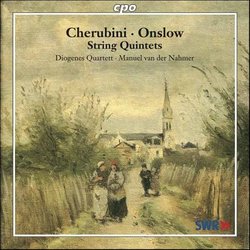| All Artists: George Onslow, Luigi Cherubini, Diogenes Quartett, Manuel van der Nahmer Title: Cherubini/Onslow: String Quintets Members Wishing: 0 Total Copies: 0 Label: Cpo Records Original Release Date: 1/1/2006 Re-Release Date: 5/16/2006 Genre: Classical Styles: Chamber Music, Historical Periods, Classical (c.1770-1830) Number of Discs: 1 SwapaCD Credits: 1 UPC: 761203718726 |
Search - George Onslow, Luigi Cherubini, Diogenes Quartett :: Cherubini/Onslow: String Quintets
 | George Onslow, Luigi Cherubini, Diogenes Quartett Cherubini/Onslow: String Quintets Genre: Classical
|
Larger Image |
CD Details |
CD ReviewsThree World Premiere Recordings J Scott Morrison | Middlebury VT, USA | 05/25/2006 (4 out of 5 stars) "The byways of nineteenth century string chamber music contain many little known works that are worth exhuming. This CD trumpets itself as containing world premiere recordings of three such works: two string quintets by the French composer George Onslow (1784-1853), and one by Luigi Cherubini (1760-1842). Considering that Onslow wrote 34 string quintets (or 36, depending on whom you read) and that Cherubini's sole quintet has been recorded before but not in the 'complete version' that appears on this CD, this claim is not hard to understand -- or dispute.
The two quintets by Onslow come from different periods in his career. The Op. 19 quintet in E Minor is rather more influenced by the so-called 'quatuor brillant' style with its virtuosic first violin part more or less simply accompanied by the remaining strings. It does have occasional contrapuntal interest although there is a fair amount of octave doubling apparent. There is more than a little dogtrot rhythmic sameness, particularly in the first movement, and the quintet's interest derives primarily from its melodic charm. Written primarily for home performance -- the Paris of Onslow's time was not particularly given to public performances of chamber music -- the quintet is probably within the reach of moderately advanced amateur players. Like the other two quintets recorded here, it uses two cellos based on the model made familiar by Boccherini's 100-plus quintets. It is a bit of a shock, then, to hear the opening bars of the Op. 51 quintet in G Minor written some thirteen years after the Op. 19. The startlingly chromatic theme announced by the second cello is only the first of a number of advances contained in this quintet. There is considerably more, and more expert, counterpoint, greater variation of rhythmic interest, almost no octave doubling, and use of textural variation, including particularly charming pizzicato sections in IV. Op. 19 could have been written by a Mozart manqué, Op. 51 by no one earlier than Schubert. A word for the curious about Onslow the man. His father, a British gentleman of considerable wealth, moved to France in 1781, married a French woman and sired four sons of whom George (not 'Georges' as is sometimes seen) was the eldest. In his youth he spent several years in England studying piano, and then in Hamburg with Dussek, but then returned to Paris where he studied composition with Anton Reicha, whose style his music somewhat resembles. He inherited an estate in Clermont-Ferrand where he wrote much of his music. Although France was not given to chamber music performance, this was Onslow's main interest, particularly after his three operas failed. Cherubini was mostly noted for his operatic works -- indeed his 'Les deux journées' (1790) was a model for Beethoven's 'Fidelio' -- and came to chamber music only late in his career. The opening Allegro commodo (preceded by a long largo introduction) is a sonata-allegro with a number of false endings and two distinct quasi-development sections. Particularly lovely is II, a set of andante variations on a lyrical theme. Thin textures -- two celli alone, three upper voices alone, a dramatic unisono passage for all five instruments -- are an unusual feature of the movement. The unison texture is echoed in the beginning of the scherzo (III) before the movement embarks on a highly imitative main section. There is contrast in the folksong-like trio with its musette drone. The finale also starts in unison and then becomes a fairly standard sonata-allegro. An odd feature of this dramatic movement is that the hair-raisingly fast coda is twice as long as the development section, building to a, you guessed it, unison section that is rounded off with two quick and decisive five-part chords. The melodic material of this quintet is somewhat pedestrian, but Cherubini shows himself a master of form on which he wreaks a number of interesting innovations. (Although this recording is called a world première of the 'complete version' there is no mention of this in the booklet notes by Christian Starke -- clumsily translated into English here -- and I was not able to find any information that would shed light on the statement.) The Diogenes Quartet, named not directly for the Greek philosopher of that name but for a Swiss publishing house, is based in Munich and is made up of Stefan Kirpal and Gundula Kirpal, violins, Stephanie Krauss, viola, and Stephen Ristau, cello. The cellist Manuel van der Nahmer plays the first cello part in these quintets, with Ristau taking the second cello line. Musically, this ensemble is excellent. The first violin's tone is a bit thin and this is particularly noticeable in the Op. 19 quintet that has so much for him to do. But in the other quintets where clarity and blend are paramount, his tone is more appropriate. It is unlikely that these quintets will be recorded again any time soon, so if you have any interest in them this is the recording to get. Scott Morrison" |

 Track Listings (12) - Disc #1
Track Listings (12) - Disc #1